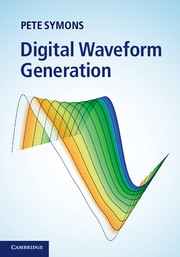Book contents
- Frontmatter
- Contents
- Preface
- Acknowledgements
- Glossary of terms
- 1 Introduction to waveform generation
- 2 The foundations of digital waveform generation
- 3 Recursive sine wave oscillators
- 4 DDS sine wave generation
- 5 DDS arbitrary waveform generation
- 6 Dynamic waveshape and spectrum control
- 7 Phase domain processing – DDS and the IDFT
- 8 Hardware implementation architectures
- 9 Digital to analogue conversion
- Index
- References
3 - Recursive sine wave oscillators
Published online by Cambridge University Press: 05 November 2013
- Frontmatter
- Contents
- Preface
- Acknowledgements
- Glossary of terms
- 1 Introduction to waveform generation
- 2 The foundations of digital waveform generation
- 3 Recursive sine wave oscillators
- 4 DDS sine wave generation
- 5 DDS arbitrary waveform generation
- 6 Dynamic waveshape and spectrum control
- 7 Phase domain processing – DDS and the IDFT
- 8 Hardware implementation architectures
- 9 Digital to analogue conversion
- Index
- References
Summary
This chapter investigates sinusoidal oscillators based upon recursive algorithms. Recursive oscillators are essentially discrete-time simulations of physical (e.g. mass-spring) oscillatory systems having a simple harmonic motion with zero damping as their solution. Accordingly, this type of oscillating system can only produce sinusoidal waveforms. The principal advantage of all recursive oscillators is their computational simplicity enabling low cost implementation. However, there are also several distinct shortcomings whose importance depends upon application. For example, non-linear frequency control, oscillation amplitude instability or arithmetic round-off noise growth over time.
There are many recursive oscillator algorithms reported in the literature, each with its own advantages and disadvantages. It is also evident that there is no single oscillator algorithm that is optimal and satisfies all requirements. As fundamentally closed-loop systems, all recursive oscillators are bound by the discrete-time Barkhausen criteria that must be satisfied to ensure sustained, stable oscillation. The classical continuous-time Barkhausen criteria require that the total loop gain of an oscillating system be exactly unity and the total loop phase shift be an integer multiple of 2π radians. In Section 3.1 we summarise the discrete-time form where we generalise the recursive oscillator difference equations using a matrix representation, as reported by [1]. In some recursive algorithms, quantised data representation and arithmetic rounding errors often lead to violation of these criteria, causing oscillation amplitude instability over time.
- Type
- Chapter
- Information
- Digital Waveform Generation , pp. 90 - 108Publisher: Cambridge University PressPrint publication year: 2013
References
- 2
- Cited by



